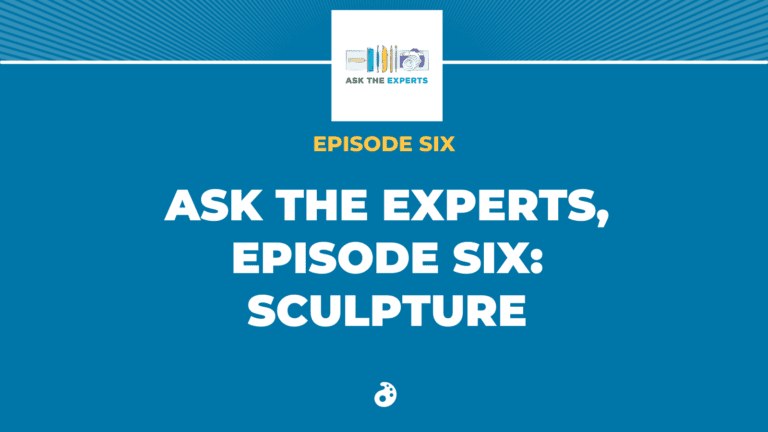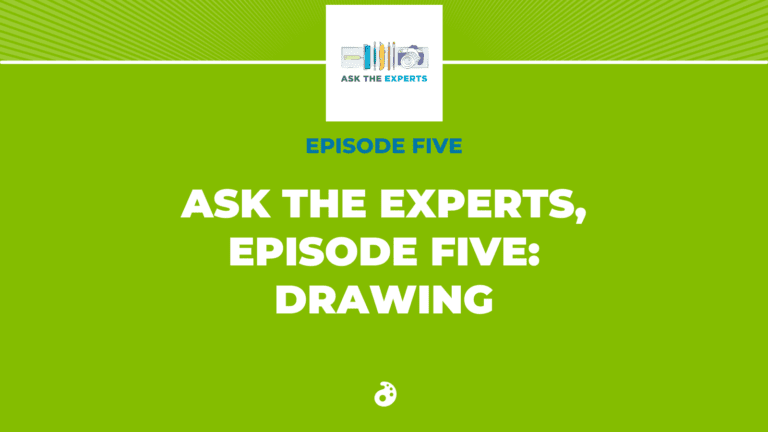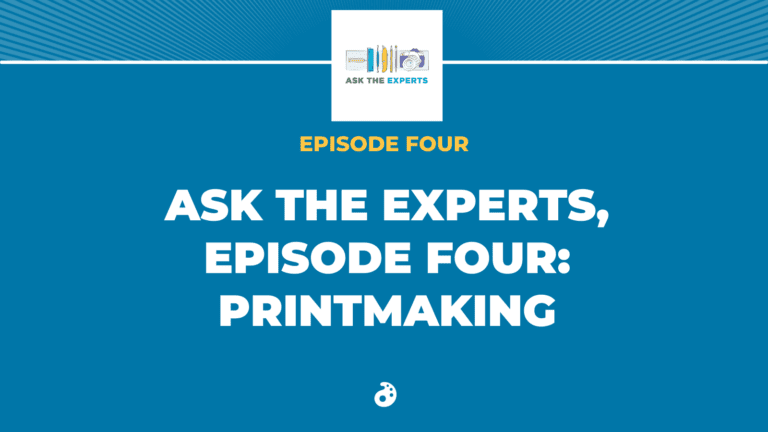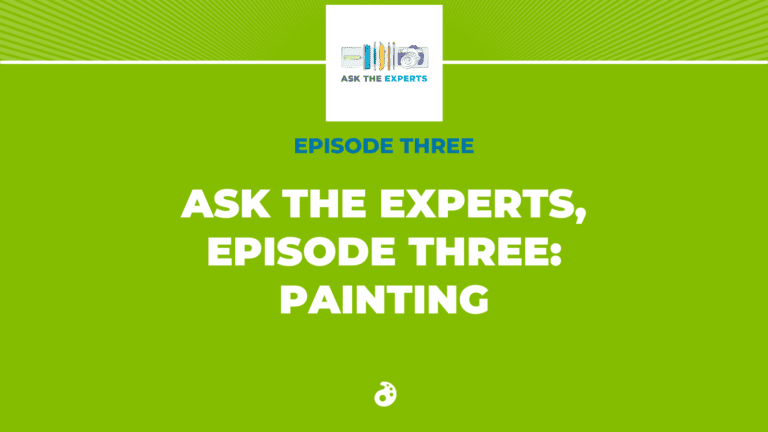As Tim continues to bring on new guests and share new ideas, he welcomes Caroline Gardner to talk about what is happening in her classroom. Listen as they discuss shibori fabric dyeing, teaching jewelry techniques to middle schoolers, and a plethora of other ideas. Full Episode Transcript Below.
Resources and Links
- Sculpture Ideas for the Art Room
- Metal Jewelry Making (Art Ed PRO)
- A Beginner’s Guide to Making Jewelry
- More Ideas for 3D Pens and Other Materials
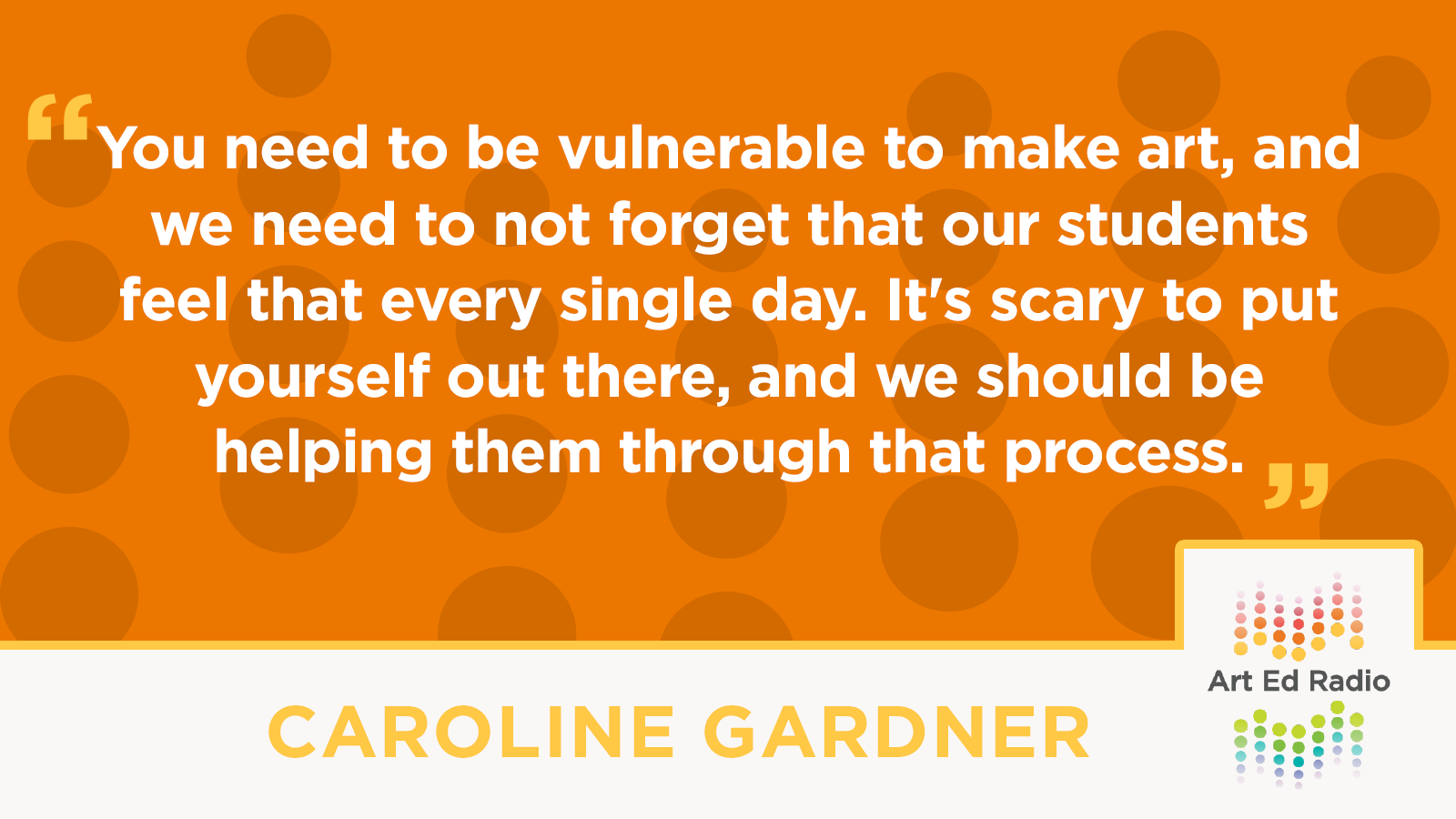
Transcript
Tim: Welcome to Art Ed Radio, the podcast for art teachers. This show is produced by The Art of Education University and I’m your host, Tim Bogatz.
As you know, if you’ve been listening over the past few weeks, we’ve been working on bringing on new voices, talking to new people, and sharing new ideas. This week I will be welcoming Caroline Gardner to the show. She has not been on the podcast before, but you may have seen her at the Art Ed NOW Conference this past summer. She shared some ideas about how she teaches art history and how she has incorporated those ideas into the curriculum in her classroom. It was a great presentation and I’m not just saying that because she featured one of my all-time favorite artists, Félix González-Torres, but because she brought in all of these incredible ideas and shared with people exactly what she does and shared how she incorporates these ideas into her classroom and they were all manageable. They were all ideas that you can start with immediately. So, I’m hoping we can get some of those same ideas going during this conversation today. Hopefully give you some thoughts, some inspiration for what you can do in your classroom.
Now, I’m also happy to be able to announce that Caroline will be coming back to the Art Ed NOW Winter Conference, which is happening February 1st of next year. So, February 1st, 2020. It’s a Saturday, by the way. We will have over 20 presentations that are all online, all incredible, and all relevant to what you’re doing right now in your classroom. There are going to be opportunities for hands-on artmaking, for new ideas for your classroom. We have inspiration and we have a full day of relevant and engaging professional development. And all of those innovative and inspiring talks, new ideas, resources, downloads, everything you can use throughout the year and everything that’s going to work for you. So you can learn everything you need to know about the conference at artednow.com, at artednow.com. So, make sure you go check that out after the episode is over.
But until we actually get to Caroline’s presentation in about four months, we’re going to spend our time talking about what she’s currently doing in her classroom with a variety of different media. I will let her introduce herself and share. But she does some great things with fibers, and sculptures, and even metals. And she does those things with middle schoolers even. So, as you probably know, I have very little confidence in middle schoolers, so I’m always impressed with someone who can challenge them and do some advanced work, especially when you’re working with materials that are a little bit different and honestly can even be somewhat dangerous if you’re not doing them correctly. But like I said though, she can explain all of those processes in a concise way. So, let me bring her on and she can share her expertise.
All right. Caroline Gardner is joining me now. Caroline, how are you?
Caroline: I’m good. Thanks for having me.
Tim: Oh good. Now since this is your first time on the podcast, I would love to have you just give us a quick introduction. Can you tell us about where you teach? What you do? What you’re interested in? Everything that’s going on in your classroom?
Caroline: Yeah, yeah. Yep. So, I’m Caroline Gardner and I am an art teacher in a progressive independent school in downtown Chicago. I teach a lot of grades. This year I’m doing 2nd grade through 12th grade.
So I’m running around. It’s so much. Normally it’s 5th through 12th. But there was a little switch this year. So, I get an extra couple of grades. So, it’s never boring for sure. But I teach a lot of general ed classes and a couple of unusual fun ones. I teach metals and jewelry in 8th grade and in high school and then fibers classes at multiple levels. So, it’s a lot of fun.
Tim: Yeah, that’s awesome. Oh, were are you going to say something else? I’m sorry.
Caroline: Oh yeah, I was just going to say that I’m an oil painter by training and I’m just wrapping up a 100 painting challenge I at 94. So, I’m going strong.
Tim: Oh, that’s amazing. That’s really, really cool. That’s something to admire, for sure. Now, you mentioned fibers, and sculpture, and jewelry, and those are kind of the things I want to talk about today because I know you’re doing just some awesome with that.
Caroline: Yeah.
Tim: So can we start with something simple, like something that, I would guess, just about every age group can do, which is shibori dyeing. I know you do a lot of that.
Caroline: I do.
Tim: Can you talk about maybe how you teach dyeing and if you think it’s something that other teachers can and should do in their classrooms?
Caroline: Yeah, definitely. I love fabric dyeing. I first got into it in college. I took a lot of fiber arts classes. It was second to painting as my favorite medium to work in. I’m always surprised at how few people have exposure to it.
Tim: Oh, very true.
Caroline: Because it’s really something you can do, yeah, in class. And fiber or fabric dyeing is really great for kids. It’s kind of like magic. It’s really fun to bring into the classroom and shibori, especially, which uses traditional indigo dye, is really cool because it’s an oxygen-sensitive process, so you can see the dye working as it’s exposed to air. So it’s a really fun process that they can watch happening. Any age can learn different kinds of folds. So you can up the complexity if you have older kids. But you can also teach little kids to fold fabric and dip it in the dye and then depending on what you want to do with it, you know like my little kids make pillows, but then my high schoolers are learning to do zippered pouches. But you can do anything with these beautiful fabrics like a fabric landscape wall hanging so much more.
Tim: Yeah. That’s really cool. Those are some good ideas. I guess, can you talk us through the process a little bit? Like if you have a kid who wants to make a pillow, could you talk us through what you do from beginning to end?
Caroline: Yeah.
Tim: Like what that process looks like in your classroom?
Caroline: Right. So we just use white cotton and like cut up different sections of the cotton. Then they learn different types of folds, like accordion folds, different kinds of clips that we can use to make interesting shapes, and they fold up a whole bunch. Maybe five to ten folds. Then we take it over to a big vat of indigo dye that you usually prepare the day before. You put on really big rubber gloves, and they dip the fabric into the indigo dye. Stir it around for about two minutes. Then they pull it out and it sits on like some plastic for 20 minutes. After 20 minutes, you open it and you see the oxygen getting in there, exposing the indigo dye, and it starts to change colors. You rinse it out in water. Then we hang it. We usually hang a big string across the windows so we can see the color shining through the window. It’s beautiful and all the fabric just hangs there and dries. Then we’ll take that and start learning our sewing lessons from there. So, it’s a fun, really two day to make the fabric and then a couple more days to do a project with it.
Tim: Yeah, that’s really cool. That sounds like an awesome process. And, like you said, it’s a simple thing that a lot of kids can do. So, that’s really cool. Now something that maybe isn’t quite as simple, something else I want to ask you about was jewelry because I know you do that a lot. You said you do it with middle-schoolers. So question one is that safe? Can you trust 8th graders with jewelry?
Caroline: Yes, you can.
Tim: But a little bit more seriously, what types of projects do you do with them? Where do you start the jewelry process? Where do you start their learning and how does that develop through the years?
Caroline: Yeah, so I started in 8th grade, although it could be done younger. I just don’t teach 3D at younger ages, I teach the 2D classes. So, in 8th grade, I find it’s really great for them because they love being treated like they’re older than they are.
Tim: Yes.
Caroline: So they find using the torches to be something that they really engage in, and I get better behavior when we’re doing the metals unit than I do any other time because they’re really excited about it and they love being trusted with something. So, we get the torches out and they do take the responsibility seriously. We have a whole talk about it. In fact, I’ve only had one incident where I’ve got like a scorched spot on my cabinet, right above the torch station, and I love that spot now. I need to give it a name because the kids … I can point to it and say, “How did this happen? What do you think happened here?”
So it’s my perfect representation of what happens if you’re not paying attention. So, that’s a great, great learning tool right there. But yeah, they get really into it. We are making, we usually do textured band rings, so it requires some math. They have to measure their finger. If they end up with a ring that’s gigantic, there’s some math that went wrong in the process so they can kind of quickly see what happened there. We usually do boot camp so they can learn the skills of cutting, texturizing, sanding to get those skills down. Then they learn measuring and we’ll do a soldering demo so they learn how to do a soldering connection and it just takes a couple of days to get through it. But they really love it. I see the kids wearing their rings the next year, which is really fun. It’s something tangible they can use.
Tim: Yeah. That’s really cool. I like that a lot. I also wanted to ask you too, sort of beyond the jewelry, I know you have a laser cutter.
Caroline: Yeah.
Tim: I would love for you to just kind of tell me about that. First of all, how did you get a laser cutter for your classroom? And then, I don’t know, I guess I’m just thinking like from a teacher’s perspective, what is the learning curve for that like when you have a laser cutter?
Caroline: Right. Right.
Tim: What was the process for you getting into that first of all?
Caroline: Right. Well, I’m very fortunate in that I don’t have to maintain it. It lives in our library.
So, I don’t have to take care of it, which is super nice. So I just get to use it and don’t have to maintain it. So yeah, we got some 3D printers and some laser cutters in there. So what I’m doing this year, it’s new, we’re having the students design a piece that can be cut in acrylic or wood and then it’s going to go onto a metal base that they’re making by hand. So, we’re just designing in Google Draw. So, a very simple program. Which, of course, they know how to do already. So they’re just creating shapes and layers. Then we’re sending that off to the library and they print it for us and then get it back to us. So, it’s a nice tool to have and then they can see how we can bring …
Because they’re always complaining, “Well, I have to cut this by hand,” when I make them cut their jewelry, you know? “Don’t we have machines do this?” So, I like to incorporate some machines that do some of the work for us, while we’re still learning how to do things by hand and combining those together. The other thing I want to do with the laser cutter this year is to have the laser cutter print some frame looms for us so we can do different shapes of looms. I love weaving. So yeah, it’s been really nice. But if you don’t have a laser cutter there are places that you can just send your designs and they’ll print it for you too.
Tim: Okay. That’s really cool. Can you, I guess, dive in a little bit more with the projects that you do with that? Like what kind of assignments do you have for your kids when you’re doing the laser cutter?
Caroline: Yeah. A key chain is the way I like to start because it gives you kind of a simple two-layer piece. So, they’re designing, it’s really similar to like graphic design. They have to think about positive and negative space, how these two layers work together, whether it’s going to be a translucent top layer, or are you going to use something solid? How is that going to reflect the metal underneath? So, creating just a basic key chain is the first step. Then from there, they can start creating three-dimensional objects. So creating a box where there’s different layers that are attached on top to push them a little bit further. That’s usually more at the high school level. The 8th graders usually stay a little bit more 2D with the metal and the laser cutter.
Tim: Okay, cool. Cool. So, thank you for just kind of sharing that.
Caroline: Yeah.
Tim: Now I know that not everybody has access to a laser cutter and not everybody has supplies for jewelry. So, I wanted to ask your advice for people who can’t teach metals, can’t teach jewelry, or maybe just don’t want to. Can you share a little bit more about, you know, other ideas you have, other things that you do in your classroom outside of those particular media?
Caroline: Yeah, so what I’ve done lately is switch over from clay to Sculpey in my middle school classes. I wasn’t seeing them frequently enough. The clay was drying out, it was becoming a whole big problem. So, we switched over to Sculpey, which has been really fun. They’re doing like five-inch, four-inch busts of people that they admire. So, we just have like a five-ounce cup, some tinfoil to make an armature, and then they’re building on top of that. It’s been fun to teach like color mixing with the Sculpey to work on facial proportions. It’s been a really nice alternative and the results have been really, really impressive. So, the kids have been happy with how those are turning out. So, that’s a nice alternative to clay. I like that a lot.
Tim: Yeah. That’s really cool. Then I guess just last thing before we get out of here, can you tell us a little bit more about that awesome painting challenge that you’re doing and I guess just a little bit more about your own work that you like to do?
Caroline: Yeah. Yeah. So, I feel like this is a familiar story, but maybe not. When I left college and became a teacher, it was hard to be an artist and a teacher at the same time. And so, my art practice kind of fell off. Then as I got further and further away from college and further away from having a teacher of my own and other students to critique with, it became harder and harder to make my own artwork. I just almost didn’t know how to get back into it. Then fear starts to creep in.
Tim: Yes.
Caroline: And, can I really do this well, creeps in.
Tim: Yes.
Caroline: And it like builds and builds and builds. And then my own teaching kind of starts replacing it and just doing demos becomes my own artwork. You know, it’s a slow process over a number of years, but it’s hard to get out of that. So, the most wonderful thing happened to me. I fell and broke my wrist in two places.
Tim: This doesn’t sound like a wonderful thing.
Caroline: It doesn’t. It doesn’t. But honestly, so many good things came out of breaking my wrist. As an art teacher, I mean, it was like imagine wedging clay with just your left hand?
Tim: Oh, yeah.
Caroline: It is a huge process and my school is four floors and I teach on the first floor and the fourth floor. So, I’m running up and down carrying all these things with one arm. So, it’s a huge challenge. But I had to learn how to do everything with my left hand. Drawing demos left hand, painting, clay left-hand. It was a huge process. But I used it to get to stop being scared of making my own artwork again. So, I said, “You know, I’m going to start painting again for myself and if it’s bad, it’s okay. It’s my left hand. Like it’s not my fault if it’s bad.” It took that fear away, which I have used in my classroom too thinking about how vulnerable it is and how scary it is to make art sometimes.
So yeah. So I started painting with my left hand for a couple of months until I could use my right hand again. Then I switched back. But it totally got me through that scary part of can I still do this? And so, I challenged myself to do a hundred small paintings.
Tim: Wow.
Caroline: And it’s just been really fun, because you learn so much when you’re doing small, like small paintings that you can kind of quickly turn over. The learning rate is so high. So, it’s just been really liberating too.
Tim: Yeah. That’s really cool. I love that. I don’t know, just I love everything about that story. Just yeah, how you’re getting over fear. How you’re just cramming so much in. But, like you said, that learning curve when you’re churning out work so quickly, that’s an amazing thing.
Caroline: Right. Right.
Tim: So, cool. Well, all right, well Caroline, thank you.
Caroline: Yeah.
Tim: Oh, go ahead. Tell me what else are you going to say?
Caroline: No, no, no. I was just thinking about how just how vulnerable it is to make art and to not forget that our students kind of feel that every day, especially the kids that don’t want to be in our classes. How scary that is to put themselves out there. So it just is a good reminder that it’s hard and scary and whatever we can do to make that process a little bit easier for them.
Tim: Yeah, absolutely. That’s very well said and I think that’s some great advice. So, cool. All right, well thank you, Caroline. It has been awesome talking to you. I’m so glad we got you on the podcast and hopefully, we can have you on again soon.
Caroline: Thank you so much. Yeah, it sounds great.
Tim: Thank you so much to Caroline for coming on. Not only did she have some incredible ideas of what you can do with fibers and dyeing, as well as sharing what she’s doing with jewelry, and metals, and sculpture. She had some wise words that were just full of inspiration, and I loved what she had to say about remembering how vulnerable you need to be in order to create, and especially thinking about that vulnerability when it comes to our kids and their creations and putting themselves out there with their art. So, I hope you are able to take away some ideas from this conversation. Maybe think about if you can bring any of those ideas into your classroom, and more than anything, I hope you can spend just a minute reflecting on that idea of vulnerability and what it means for our students and what it means for everyone who wants to make art.
Art Ed Radio is produced by The Art of Education University with audio engineering from Michael Crocker. Next week we have some Halloween plans where we can talk art history and hopefully be kind of entertaining with it. So, we will talk to you then.
Magazine articles and podcasts are opinions of professional education contributors and do not necessarily represent the position of the Art of Education University (AOEU) or its academic offerings. Contributors use terms in the way they are most often talked about in the scope of their educational experiences.
